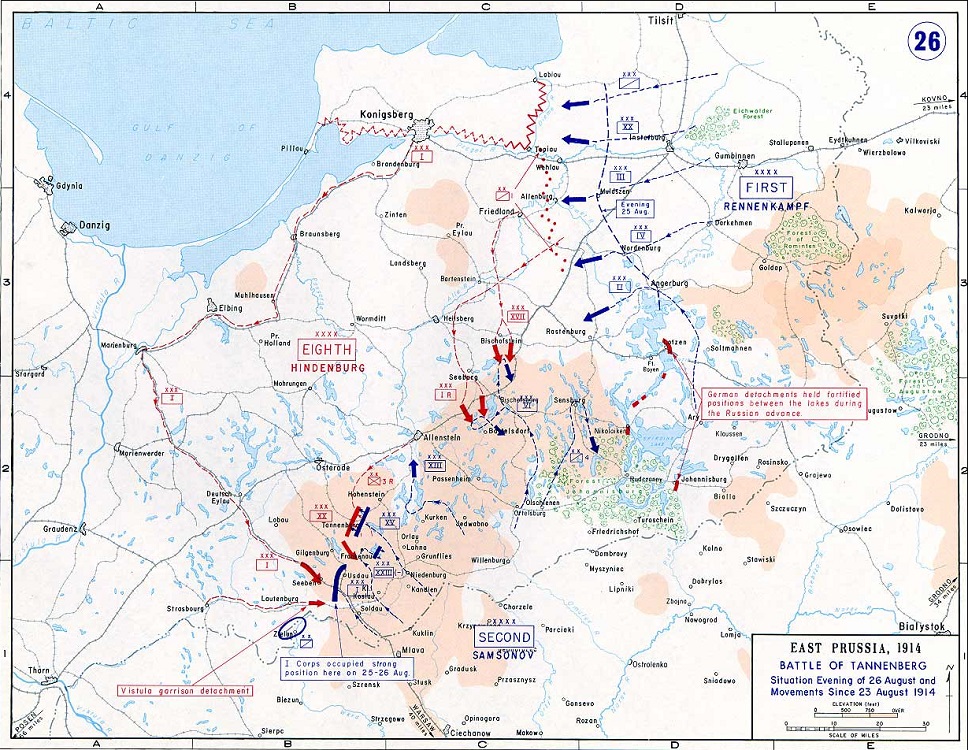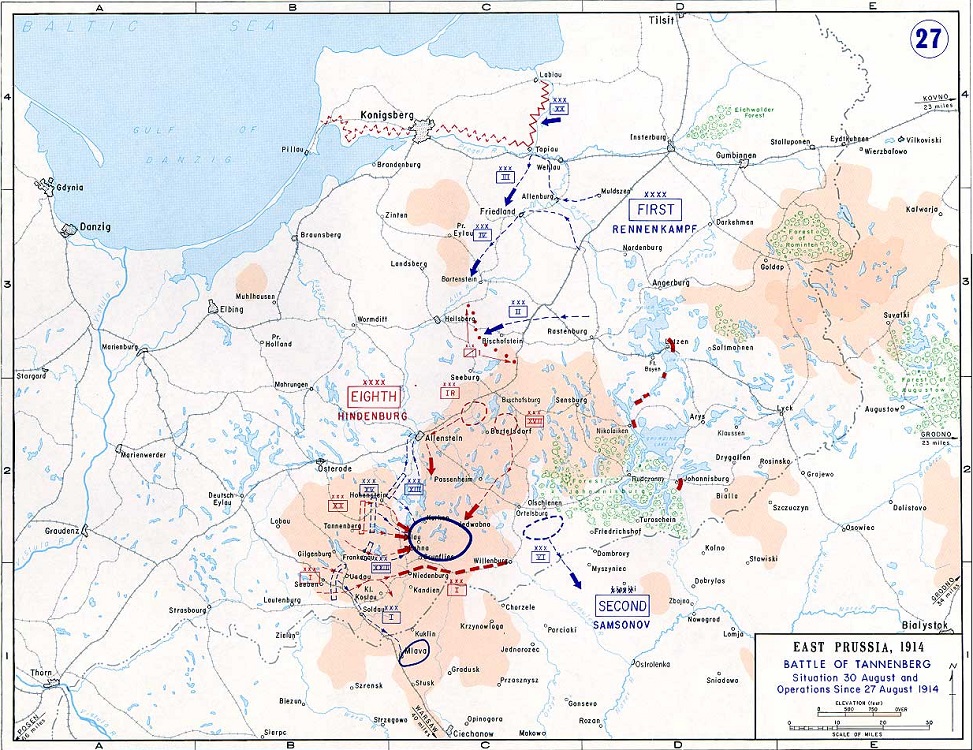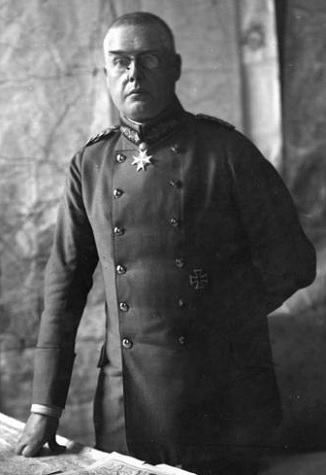● ● ●
For clarity, German units are
rendered in italics.
Legends soon began to cluster around the famous Battle of Tannenberg.
It was claimed, for instance, that in the years before the
war General von Hindenburg had studied the problem of
defending East Prussia and developed the plan that produced
victory in August 1914. But this was no more than patriotic
mythmaking, designed to bolster Hindenburg’s reputation. In
fact, Eighth Army more or less had its course of
action laid out for it by the military geography of the
region and the configuration of the rail net. By the time
that Hindenburg and Ludendorff arrived at the Eighth
Army’s headquarters its staff officers, a certain
Colonel Max von Hoffman prominent among them, had the actual
plan ready: Rennenkampf’s First Army in the north would be
held off by a thin screen of cavalry and Landwehr
brigades while the bulk of the German forces hurried south
to confront Samsonov’s Second Army.
On the
other side, the actions of the two invading armies were
becoming more and more disjointed. Their higher
headquarters, Northwest Front, was far in the rear at
Volkovysk
and its commander, Zhilinskiy, provided nothing by way of
direction beyond exhortations to speed up the advance.
Despite having won a tactical victory at Gumbinnen,
Rennenkampf was convinced that he faced most of Eighth
Army and could not resume the offensive until his supply
service sorted itself out. Samsonov was more receptive to
Zhilinskiy’s prodding. His troops had first met the German
XX Corps on 22 August and pushed it back in several
places. This encouraged Samsonov to press on despite his own
supply problems. Zhilinskiy repeatedly demanded that First
Army get moving so as to support Second Army’s attack. But
Rennenkampf was not short of excuses for doing nothing:
German opposition, his own army’s exhaustion, lack of food,
fodder and ammunition.

Department of History, USMA West Point
As
Zhilinskiy nagged, Rennenkampf sat still and Samsonov
marched into East Prussia, Eighth Army's redeployment
was completed. By 25 August I Corps had been
transported from the
Königsberg
area and occupied a strong defensive position facing Second
Army’s left flank. I Reserve Corps and XVII Corps
had similarly been moved to positions facing Second Army’s
right flank. The redeployment had been conducted smoothly
and rapidly: a tribute to the efficiency of the Eighth
Army staff. And of all this Samsonov had no inkling. He
thought that only his center faced a major concentration of
German troops in the form of XX Corps, and that the
prospect of a great victory beckoned. His plan was for
Second Army’s center in the strength of three corps to
attack XX Corps, nailing it in place. Meanwhile
Second Army's left and right flank corps would advance to envelop
the enemy and complete his destruction.
But in
reality Samsonov was leading his army into a trap. On 26 August, after an intemperate argument with Ludendorff over his supply situation, General von François
launched I Corps into an attack on the Russian right
flank. His corps artillery had not all arrived, however, and
François did not press the attack too strongly that day. On
the front of XX Corps there was heavier fighting, one
Russian infantry division being largely destroyed. But
Second Army was still gaining ground and at Eighth Army
headquarters nerves began to fray. A report that First
Army's advance was picking up speed moved Ludendorff to
suggest that the battle should be broken off. But Hindenburg
steadied his Chief of Staff and the report was soon found to
be exaggerated.
Also
on 26 August Eighth Army was notified by OHL that
three corps and a cavalry division from the western armies
were being dispatched to East Prussia. Still confident of
victory in the West but concerned about the situation in the
East, Moltke thought that he could spare the troops.
Ludendorff replied that the battle would be decided before
the reinforcements could arrive; however, he added, they’d
certainly be welcome.
But
there was no real reason for Moltke’s concern. On 27 August,
with his artillery concentrated and his troops resupplied,
François launched a full-scale attack that drove the Russian
left flank (I Corps) back in confusion. The same thing
happened on the Russian right, where XVII Corps and I
Reserve Corps, now fully concentrated, attacked and
drove back VI Corps on 27-28 August. That left Samsonov’s
center group—three corps strong—in a perilous position, with
German forces advancing past both its flanks. This,
ironically, was the fate that the Russian commander had
planned for XX Corps. By the time Samsonov realized
what was actually happening, it was too late. Troops of I
Corps and XVII Corps made contact on the evening
of 28 August, encircling the three center corps of Second
Army. Samsonov ordered a retreat but the German cordon
prevented all but isolated groups from slipping away.
Throughout the day on 29 August the Russians launched
desperate attacks in an effort to break out, thousands dying
in the attempt. By 30 August the surrounded troops had lost
all cohesion and mass surrenders began. But General Samsonov
was not among the prisoners. He chose instead to commit
suicide, lamenting to his staff: “The Tsar trusted me. How
can I face him after this disaster?”

Department of History, USMA West Point
In
all, Second Army lost 78,000 killed or wounded and 92,000
made prisoner. Three corps were completely annihilated and
two more were chased out of East Prussia in disorder. At the
end of August the remains of Second Army amounted to less
than the strength of a division: perhaps 12,000 troops in
all. As for First Army, it had indeed resumed its advance in
26 August, albeit moving at a snail's pace. The aggressive
behavior of the German screening force—cavalry supplemented
by Landwehr troops drawn from the garrison of
Königsberg—continued
to convince Rennenkampf that he was facing much stronger
opposition. On the day of crisis, 28 August, his leading
troops were still fifty miles distant from Second Army’s
right flank.
Having
disposed of Second Army, the Germans redeployed back to the
north. A week after Tannenberg, in the First Battle of the
Masurian Lakes, First Army was driven out of East Prussia.
With the lesson of Samsonov’s catastrophe before his eyes,
Rennenkampf made sure to retreat in good time and his army,
though badly battered, regained Russian soil in one piece.
Though
Tannenberg was certainly a major victory that gave a
tremendous boost to German morale, it was far from decisive.
Even as Samsonov’s army was being destroyed, fresh Russian
forces were reaching the front in ever-greater numbers. In
Galicia, the Austro-Hungarian Army had met disaster. And far
away in France, the German offensive was beginning to
falter. Tannenberg had gained for Germany a breathing space,
but it was becoming clear that the war would continue for a
long time.
Tannenberg did show that the German Army was a military
instrument of considerable efficiency. As has been noted the
correct line of operations in East Prussia was obvious from
a glance at the map. It was in the execution of that
operation that German superiority was revealed: the handling
of reserves, the quality of the staff work, the management
of the rail net. The Russian Army did not lack for brave
soldiers. It had some if no surplus of capable commanders. In
1914 it was reasonably well armed and equipped. But there
was nothing on the Russian side to compare to the German
Army’s
Großgeneralstab (Great
General Staff) or even to its NCO corps, whose excellence
explains why even second-line Landwehr formations
fought so effectively. That the Germans did not hesitate to
strip fortified areas of their garrisons and send such
relatively elderly reservists into the field demonstrated a
level of confidence in NCO leadership that other armies did
not share.
After
Tannenberg rumor suggested that the mutual animosity of
Rennenkampf and Samsonov deterred the former from hurrying
to the latter’s relief. Supposedly the two had argued
violently during the Russo-Japanese War and actually came to
blows on a railroad station platform in Manchuria. While the
personal factor should never be discounted—think of Hitler’s
deep dislike of the officers who dominated the German
General Staff—there probably was nothing much to such
stories. Rennenkampf’s caution was natural enough in the
circumstances; in any case no action was taken against him
at the time. His dismissal from the Army in October 1915 was
due primarily to suspicions about his ethnic background:
Rennenkampf was a Baltic German, born in Estonia, and with
the war going badly for Russia such men made for
convenient scapegoats. He was even tried for treason but was
acquitted and permitted to retire with full pension rights.
But in 1918 he was arrested by the Bolsheviks and after
refusing a demand to take service with the Red Army, Rennenkampf was shot.
On the
German side, Generals Hindenburg and Ludendorff were hailed
as the saviors of East Prussia and the prestige they gained
thereby was destined to elevate them to the summit of power.
But the famous partnership was not as smooth as legend had
it. Hindenburg was quite well aware that his Chief of Staff
regarded himself as the real brains of the operation, with the
former serving largely as a figurehead. For his part Ludendorff resented the share of credit that went to
Hindenburg for victories that he, Ludendorff, believed were
due to his own genius. In truth the two men complimented one
another, though not without friction. Stolid, phlegmatic,
unimaginative but decisive, Hindenburg (usually) provided
the steadying hand that Ludendorff, intelligent, driven,
highly professional but nervy and high-strung, so greatly
needed.

The indefatigable diarist:
Max von Hoffmann (Bundesarchiv)
As for
Colonel Max von Hoffman, who was deputy chief of operations
at Eighth Army headquarters during Tannenberg, it is
to his diary that we owe much of our knowledge of what went
on during those days of crisis. An extremely intelligent man
with a sardonic streak, he was known to say that the famous
Duo had received the plan of battle ready made on the day of
their arrival in East Prussia—a claim with a good deal of
truth in it. Hoffman remained on the Eastern Front
throughout the war, playing a notable role in later battles
and campaigns.